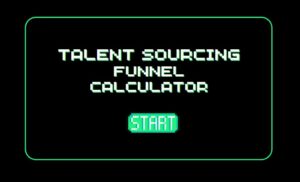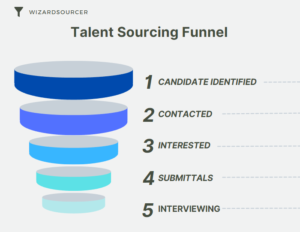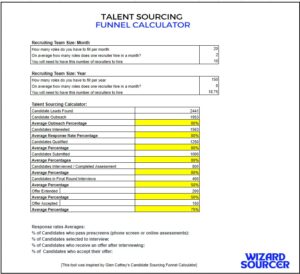
A talent sourcing funnel in recruiting is a process that hiring teams use to identify and attract candidates for job vacancies. It is a structured approach to sourcing, screening, and selecting the best candidates for a role. The talent sourcing funnel typically consists of several stages, each with its own set of activities and goals. Overall, tracking the funnel is critical to the success of the recruitment process. It helps recruiters and talent sourcers to optimize their workflow, provide a positive candidate experience, and make data-driven decisions to achieve their hiring goals.
I was impressed by Glen Cathey’s Candidate Sourcing calculator but wanted to make adjustments to it.
Have you ever wanted to answer these talent sourcing metric questions?
- What is the volume of resumes, social profiles, and names you need to assess in order to make a successful hire?
- How efficient is your hiring process, from sourcing candidates to recruiting and selecting the best fit for the job?
- How many candidates do you need to consider in order to fill a vacant position?
- In what ways can refining messaging and engagement strategies enhance the efficiency of your hiring process?
- How many new hires can a sourcer or recruiter impact each month through their daily activities?
- How many sourcers or recruiters are needed to achieve a target number of hires per month?
Importance of Tracking Metrics:
It is essential for a recruiter and talent sourcer to track their talent sourcing funnel for several reasons:
Accountability: By tracking their funnel, recruiters and talent sourcers can hold themselves accountable for their progress and results. It helps them to understand their performance and identify areas where they need to improve.
Efficiency: Tracking the funnel enables recruiters and talent sourcers to measure their effectiveness and efficiency in each stage of the recruitment process. It helps them to identify bottlenecks and areas where they can streamline the process to make it more efficient.
Candidate experience: Keeping track of the funnel ensures that candidates receive a consistent and positive experience throughout the recruitment process. By monitoring each stage of the process, recruiters and talent sourcers can ensure that candidates are engaged and informed at every step.
Better decision-making: Tracking the funnel provides recruiters and talent sourcers with valuable data and insights, which they can use to make better-informed decisions. It allows them to evaluate the effectiveness of different sourcing and engagement strategies and tactics, and make data-driven decisions to improve their hiring process.
Goal-setting: By tracking their funnel, recruiters and talent sourcers can set realistic and achievable goals for each stage of the recruitment process. It enables them to measure their progress towards these goals and make adjustments as necessary to achieve them.
Here’s the typical stages of a Talent Sourcing Funnel:

A talent sourcing funnel typically comprises of several stages, including identifying candidates, making contact, assessing their interest, screening and submitting candidates, and ultimately, moving candidates into the first round of interviews.
Talent Sourcing: In this stage, recruiters use a variety of methods to attract potential candidates. This may include posting job advertisements on job boards, using social media, attending job fairs, and networking. It’s fully comprised in the above talent sourcing funnel image.
Screening: Once candidates have been identified, recruiters will screen them to determine if they meet the minimum requirements for the position. This may include reviewing resumes and cover letters, conducting phone screens, or administering skills tests.
Submittals: Once the interviews are completed, the hiring team selects the best candidate for the position. This may involve conducting reference checks or background checks.
Interviewing: Candidates who pass the screening stage are invited for interviews. Depending on the position, there may be one or more rounds of interviews, which may be conducted in person, over the phone, or via video conferencing.
Offer Accept/Hire: The final stage of the funnel is making the job offer and onboarding the new hire.
Talent Sourcing Funnel Calculator
Create a Talent Sourcing Metric Funnel Calculator using this Google sheets example template.
[Use this link to download the calculator on Google Sheets here]
Recommended Reading:
Recruiting books to read in 2023 and Beyond
How recruiters can generate Boolean Strings using ChatGPT
Free Chrome Extensions for Recruiters and Sourcers in 2023
- AI Search Will Transform Talent Sourcing Forever - January 10, 2025
- Build an AI Sourcing Assistant using ChatGPT 4 - January 10, 2025
- Top Recruiting Leaders to Follow in 2025 - January 8, 2025

